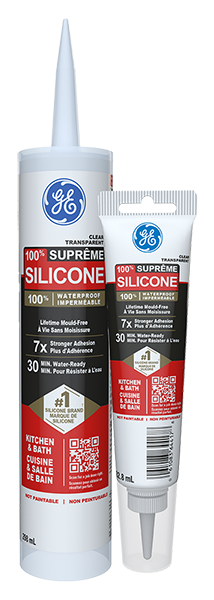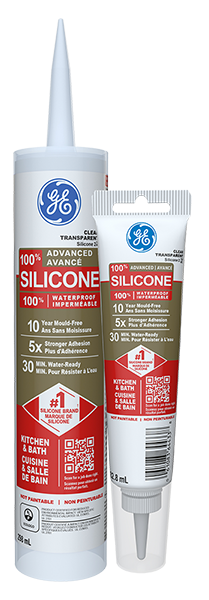Note: This DIY article is provided as a general guide only and is not intended to take the place of product-specific installation procedures; always follow applicable manufacturers’ instructions. Depending on your home’s age and condition, location within the home, and other potential factors, repairs and/or upgrades or other services may be necessary prior to the beginning and/or completion of your project that may involve the services of a home improvement professional. This article does not include advice pertaining to local building codes and/or any related inspections.
Caulk and sealant are essential products for sealing gaps and joints in various home improvement projects, but they are not exactly interchangeable. Understanding the differences between the two will help you choose the right material for the job. This guide explains what caulk and sealant are, when to use adhesive caulk vs silicone sealant, and other various key distinctions between them.
What is caulk?
Caulk is a flexible, gunnable material — gunnable in this context means capable of being loaded into a gun-type dispenser — primarily used to seal gaps and joints in interior applications. With a movement capability — a measure of a substance’s malleability — of less than 12.5%, caulk is ideal for areas with minimal expansion or contraction. It’s commonly applied to close small gaps and prevent air leakage around:
- Windows
- Doors
- Baseboards
- Crown moulding
While caulk provides a neat finish, it doesn’t have the same level of flexibility or durability as sealant, making it better suited for areas without significant movement or extreme weather conditions.
There are several types of caulks available, each designed for specific uses.
- Acrylic and latex caulks are popular for interior work because they are paintable and easy to clean up with water.
- Adhesive caulk, a more specialized option, provides additional bonding strength and is often used where structural integrity is needed.
While caulk can offer some moisture resistance, it is not suitable for waterproofing or high-moisture areas, such as bathrooms or kitchens. Choosing the right caulk for your project ensures a long-lasting, professional finish that complements the interior space.
Unlike caulk, sealant is highly malleable, with a movement capability greater than 12.5%. This allows sealant to stretch and contract significantly without cracking or losing adhesion. As such, sealant is ideal for exterior applications, such as sealing around windows, doors, and siding, as well as waterproofing high-moisture areas like bathrooms and kitchens.
What is sealant?
Sealant is a flexible, durable material designed to seal gaps and joints in areas exposed to significant movement or harsh environmental conditions. Unlike caulk, sealant is highly malleable, with a movement capability greater than 12.5%. This allows sealant to stretch and contract significantly without cracking or losing adhesion. As such, sealant is ideal for exterior applications, such as sealing around windows, doors, and siding, as well as waterproofing high-moisture areas like bathrooms and kitchens.
There are two different types of sealants, silicone and polyurethane.
- Silicone sealants are particularly known for their excellent water resistance, making them perfect for use in bathrooms, kitchens, and around plumbing fixtures.
- Polyurethane sealants, on the other hand, are more commonly used in outdoor projects where weather resistance and durability are essential.
Sealants generally adhere well to a variety of materials, including glass, metal, and tile, with long-lasting protection against moisture, air, and weather infiltration.
While sealants are typically more expensive than caulks, they provide superior flexibility and durability, making them the better choice for projects requiring long-term performance in challenging environments. Selecting the right sealant ensures a proper seal that remains intact, even under extreme weather stress.
Key differences: caulk vs sealant
The primary distinction between caulk and sealant is their movement capability. As noted, caulk has a movement capability of less than 12.5%, meaning it works best in areas with little expansion or contraction, such as interior trim or around windows. By definition, a sealant has a movement capability greater than 12.5%, with some special-use silicone sealants — such as those used in buildings with seismic resistance — exhibiting up to 50% movement capability. This enhanced flexibility allows the sealant to flex and move without cracking.
In terms of durability, sealant outperforms caulk in areas that experience fluctuating temperatures, moisture, or constant exposure to the elements. For example, silicone sealants are waterproof and can resist UV light, making sealants like Supreme Silicone Kitchen & Bath Sealant ideal for bathrooms and other areas exposed to water, whereas caulk is more suitable for dry spaces. Sealants also tend to have a longer lifespan and better resistance to wear over time.
Another key difference is in their adhesive properties. Sealants — especially silicone varieties — provide excellent adhesion to a range of surfaces, including metal, glass, and tile. Caulk, while effective in creating a seal, doesn’t offer the same level of adhesion or flexibility.
Caulk vs sealant for specific projects
Choosing between sealing vs caulking largely depends on the specific requirements of your project. For interior projects with minimal movement — such as sealing gaps in trim, baseboards, or drywall — caulk is typically the better option. Acrylic or latex caulks are ideal for these applications because they provide a smooth finish and can be painted to match the surrounding surfaces. Caulks are also easier to clean up and apply in areas where moisture exposure is minimal.
For exterior projects or areas exposed to the elements, sealant is the superior choice. Silicone sealants are designed to handle temperature fluctuations, UV exposure, and weather conditions without losing flexibility or adhesion. When sealing around the exterior of windows and doors, for instance, silicone sealant offers long-lasting protection against water infiltration and prevents drafts.
In the case of bathroom sealant vs caulk — where high moisture levels are expected — using a silicone sealant like Advanced Silicone 2® Kitchen & Bath Sealant is necessary for creating a waterproof barrier around sinks, bathtubs, and showers. Silicone sealants are mould- and mildew-resistant, making them more durable in wet environments. On the other hand, adhesive caulk might be used for projects that require some bonding strength, such as securing light fixtures or trim, but it’s not suitable for areas that need to flex and remain watertight. Ultimately, selecting the right product depends on whether your project requires flexibility, waterproofing, or durability in extreme conditions.
For all your sealing needs, trust GE Sealants Canada for high-quality products designed to meet the demands of both residential and commercial projects. Whether you need caulk for interior applications or sealant for exterior protection, our range of silicone and acrylic solutions ensures long-lasting performance. Explore our product line to find the right sealant for your next project and achieve reliable, professional results.
To get GE Sealants’ products for your home improvement project, visit these fine retailers.



